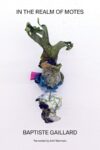
Tr. from the Japanese by Polly Barton
[Europa Editions; 2025]
I’ve become a cynical reader, one who knows what’s gonna happen in a book, who is going to narrate it (and why), and which literary moves will be made. This injury is partially from being a reviewer and partially from surviving a doctorate. Grumpily, I assumed many things about Aoko Matsuda’s The Woman Dies, even as I was excited for a new Polly Barton translation. I got out my pen and sticky notes, ready to make the usual comments and place the same exclamation points. After all, the book checked all my little boxes, especially the feminist one, so I settled in for a dour feminist analysis of our times.
But The Woman Dies circumvented my critical brain: it made me laugh, shocked me, revealed my tastes to be safe rather than incisive. I devoured the book in a single sitting, because it was everything I hadn’t known I’d been hungry for. I recommend The Woman Dies to readers who enjoy stories narrated by, among other things, national anthems, unworn sweaters, and a captive Nicholas Cage. I also recommend the book to readers who are depressed with their current social reality. More on that in a moment.
Aoko Matsuda’s collection of short fiction pieces, some new and some reprinted, published by Europa Editions, and translated by Polly Barton. Barton’s is a familiar name for readers who wait anxiously to get their hands on the latest feminist Japanese novel or story collection translated into English; she also translated Matsuda’s debut collection, Where the Wild Ladies Are (2021). She has translated other feminist novels such as Asako Yuzuki’s Butter (2024), Mieko Kanai’s Mild Vertigo (2023), and recently Saou Ichikawa’s Hunchback (2025). Barton is also the author of a wonderful memoir, Fifty Sounds (2021), about her time living in Japan and her experience of fifty onomatopoeia in the Japanese language. Her name on a book, as translator, makes it an automatic read for me.
Matsuda’s work fits within an aesthetic of the strange that runs through Japanese fiction, and especially Japanese women writers. This lineage goes back to Ryunosuke Akutagawa’s Kappa, a social satire of Japanese society published in 1927. Matsudo’s work brings to mind Sayaka Murata’s recent books like Life Ceremony and Earthlings. Murata often uses science fictional or magical realist conceits to interrogate social norms and the harm they cause, all with a healthy dose of humor. Yoko Ogawa, particularly Revenge (recently reissued), while not funny like Matsuda’s work, uses the short story form to investigate violence and upend social conventions to unsettling effect. In short, Matsuda is in good company.
Summarizing short story collections is tricky, as is reading them. Sometimes, scattered and uneven, they offer the barest of footholds for a critic. But The Woman Dies is a well-constructed collection because it is organized around a central concern: capturing the strange. Even Matsuda’s human narrators don’t quite understand the world they live in. The femme fatale narrator in the short story “Bond” doesn’t understand why she has to sleep with James Bond if she’s having such a good time with other femme fatales. The dying woman in the titular story, “The Woman Dies,” is baffled by the emphasis contemporary society places on genitals and uses her dying words to ponder the philosophical problem of reducing subjectivity to anatomy that is, in this case, aesthetically unpleasing.
Across the collection, narrators often contemplate (rather than confront) a world that is misogynist, hostile to individual variation, and stuck in old stories. “The Woman Dies” explores all the plot devices that make use of a woman’s body (death, rape, pregnancy, miscarriage), radically reducing what can be said about her. If her body is all that matters, then what of her intellectual life, her curiosity, her adventures? If she must die in every story, or suffer some unspeakable tragedy, what happens to other stories we might tell about women? How much are these tropes enforced by the profit model of art and storytelling? There is no room for these questions in the hegemonic story of female suffering which gets produced over and over again. Even the narration of “The Woman Dies” is claustrophobic, each section at the beginning like so: “The woman dies. She dies to provide a plot twist. She dies to develop the narrative.” And later: “The woman gets pregnant. She gets pregnant to generate more drama.” And so on. The repetition is part of the point. Matsuda demonstrates a kind of hypnosis within culture that infects the narrative “we” of the story, viewers and consumers of cultures who take for granted the symbolic waters in which they swim.
The funniest story is “This Precious Opportunity,” about a narrator who licks the yogurt lid to get every blob of yogurt out of the container. The narrator cannot continue with this innocuous practice after the lids begin to include aggressively cheerful messages. The lids say: “Have a great day!” Or “Counting on you!” Or “Did you lick it?” The last of these messages infuriates the narrator. What had previously been a perfectly innocent action is co-opted by the happiness industrial complex. The narrator can’t just eat her yogurt; in eating her yogurt, she has to be a productive, happy member of society! The narrator switches yogurt brands and, even though there is no message, still stops licking lids entirely. The action had become socially enforced, drained of all pleasure. I enjoyed this story for two reasons: I also lick yogurt lids and I also hate being coerced by social expectation into feeling or actions and will react in extreme ways to this kind of encroachment. While part of the humor came from self-recognition, the other part came from a kind of relief. By focusing on an absolutely innocuous moment, Matsuda captured the pervasiveness of social control and the strange reactions it can provoke.
The collection evokes this anti-social sensibility, both in form and content. The anti-social attitude could be feminist or queer or working-class or anarchic depending on the story. But formally it manifests in Matsuda’s choice of narrators. For instance, the Japanese national anthem gets three stories to itself as narrator. In another story, a sweater goes to paradise after it is donated by its owner and it tells you just how much it enjoys Hawai’i. The ethics of this vision are encapsulated in “Flora,” an installment in what Matsuda calls “The Adolescent Trilogy,” a group of stories with recurring characters. Mei, the main character, is looking at a Pre-Raphaelite painting and is amazed by the “great care” paid to the plants. Human vision, she reflects, when distinguishing human and thing “could tell, just by looking, which [thing] was most important.” Worse, human vision enacted this ranking on people: “faced with a man, a woman, and a child, a lot of people would act as though the order of importance was self-evidently man > woman > child.” Looking then, is never neutral, but always engaged in some kind of hierarchical ordering. Matsuda’s refusal to discount the narrative importance of any person, thing, or concept refuses this hierarchy. Her refusal indicates why she turns to the short story as the formal solution to these problems. Literary culture is, especially in the US, so fixated on novels it can’t ask what is being left out of the story if we ignore shorter forms. (My sense is that this is mostly economic.) But the shorter form enables a wider social vision because it doesn’t have to commit itself to 70,000 words of the same and can take considerable risks.
Matsuda’s humor is part of her feminist commitment. For her, patriarchal and capitalist social reality is too stupid to be taken seriously. The perfect story to illustrate this is “Dissecting Misogyny” in which the narrator demonstrates dismembering a body infected by misogyny. (We might assume it’s a male body.) The unnamed narrator describes, in nauseating detail, the removal of the brain (turned to “gunk”), the stomach with its foul stench, and bones that turn out to be quite brittle. On one hand, it’s a hilariously compact allegory about what it would actually mean to dismantle misogyny. On the other, it’s also funny because of the offhand suggestion that dismembering the bodies of misogynists would be useful to feminism, if only because it’s cathartic.
(Kidding…I think.)
Matsuda takes common sense and then illustrates its basic stupidity. Social convention is presented plainly but always devolves into a surreal enactment. Let’s take “The Masculine Touch.” In her one-line commentary on the story, Matsuda writes that the inspiration for the story came from her “frustration” at “how often you saw phrases like ‘the feminine touch’ and ‘the feminine perspective.’” Matsuda inverts the typical treatment of women authors, treating men with the same reductive sexist logic. The effect is incredibly uncomfortable. In the story, a male writer finds himself thrust into fame when men’s issues are all the rage. He is asked to speak “on the various topics impacting men’s lives,” going so far as to keep a blog of his feelings. He fields difficult questions such as “do you think it’s possible for men to keep on working after marriage?” Commentators are thrilled with the focus on men’s maligned perspectives: “We had come a long way from men finally being granted the vote! The Japanese government enlisted the entire country in supporting men across society.” The story’s real power is both its humor and its painful eye for detail. “The Masculine Touch” is only funny and depressing because “male” remains the default and the revelation of women as humans in their own right has not been persuasive. The simplicity of this inversion hit me full force. Matsuda deftly revealed that the logic of inclusion can be so easily co-opted, and asks us an important questions: do we really want to be included in this mess anyway?
Matsuda’s collection consoled and challenged me. Her way of thinking is a refreshing new avenue that does not take things so seriously while also being deeply committed. Just because gender politics in the US and beyond feel more conservative than ever doesn’t mean that feminists must be more conservative in our efforts. I’d encourage engagement with Matsuda, especially for young women hoping to make their mark on literature. She’ll make you laugh, scream, and wonder whether your thoughts and habits are really so weird after all.
Kaelie Giffel is a writer and educator living in Helena, MT. She is the author of University for a Good Woman: Reflections on Gender, Labor, and Class in American Higher Education (Lived Places Publishing, 2024). You can find her at her website (kaeliegiffel.com).
This post may contain affiliate links.






